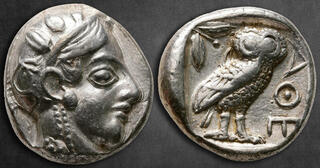| Savoca Numismatik GmbH & Co. KG > Online Auction 203 | Silver | Auction date: 24 March 2024 |
| Lot number: 236 Price realized: 600 EUR (Approx. 652 USD) Note: Prices do not include buyer's fees. | Show similar lots on CoinArchives Find similar lots in upcoming auctions on |
| Lot description: Egypt. Pharaonic Kings of Egypt. Uncertain Pharaoh circa 400-350 BC. Time of the 28th-30th Dynasties, Imitating Athens Tetradrachm AR 23 mm, 16,62 g Head of Athena right, wearing crested Attic helmet decorated with three olive leaves over visor and a spiral palmette on the bowl / AΘE, owl standing right, head facing; olive sprig and crescent behind; all within incuse square. Prior to the introduction of Macedonian issues beginning in the late fourth century BC, Egypt relied upon the use of imitations of Athenian tetradrachms for its international transactions. Although its presence as a major power in the eastern Mediterranean extended over two millennia, Egypt had never struck its own currency, relying instead on payment-in-kind and specie payments. By the end of the sixth century BC, the presence of Greek traders drastically altered this arrangement. Beginning with the establishment of Naukratis in the Delta, Greek coin-types, along with a steady supply of silver, flowed into Lower Egypt. There some of this material was melted and re-struck into into more localized imitative types, which then circulated into Phoenicia and points eastward. One is the 1989 Syria Hoard, containing numerous examples of these imitative types, as well as examples from the final period of Egypt as a Persian satrapy. Although the Persian Empire already had a long and well-established monetary system, these imitative Athenian tetrdrachms circulated in areas in which they were already a recognized and accepted currency, allowing the satrapy of Egypt to continue its trade in those areas unimpeded. For a more detailed discussion of Athenian imitations in Egypt, see P. van Alfen, "Owls From the 1989 Syria Hoard," AJN Second Series, 14 (2002), pp. 1-58. Hints of doubling, Near Extremely Fine. Cf. Flament style X; Cf. Van Alfen pl. 11. Before the late fourth century BC, when Macedonian currency began to be introduced, Egypt primarily engaged in international transactions using imitations of Athenian tetradrachms, despite its longstanding prominence as a dominant force in the Eastern Mediterranean over a span of two millennia. Historically, Egypt had not minted its own coins, instead depending on barter systems and payments in bullion. However, the advent of Greek commerce profoundly transformed this traditional economic framework towards the end of the sixth century BC. With the founding of Naukratis in the Nile Delta, an influx of Greek coin designs and a consistent stream of silver began to permeate Lower Egypt. There, significant quantities of this influx were reforged into localized imitative variants, subsequently permeating markets as far as Phoenicia and beyond. A notable discovery underscoring this phenomenon is the 1989 Syria Hoard, which comprises numerous specimens of these imitative coins, alongside pieces dating back to Egypt's tenure as a Persian satrapy. Despite the Persian Empire's extensive and established coinage system, these mimetic Athenian tetradrachms found utility and acceptance in regions where their value was already established, thereby facilitating uninterrupted trade activities for the Egyptian satrapy within these zones Starting price: 500 EUR |  |


